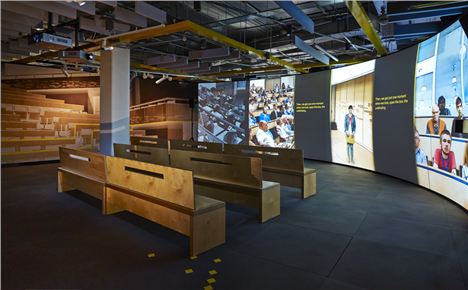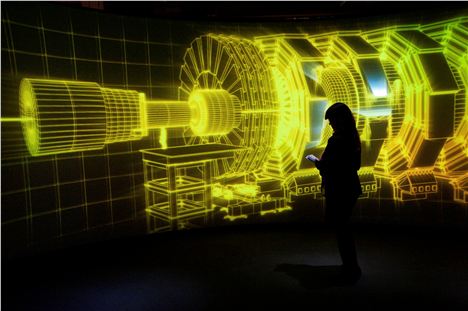“Why Manchester you ask?” said Museum Director Jean Franczyk. “Because Manchester is where it all started. Manchester was the beginning of the modern world.”
If you've absolutely no interest in trillions of protons smashing together at 99.999999% the speed of light, spawning temperatures more than 100,000 times hotter than the heart of the sun in order to recreate the very beginning of everything, then I really wouldn't bother.
“Let’s not forget,” interjects Professor Jeff Forhaw, particle physicist at the University of Manchester (interviewed here), “The starting point for all particle physics was in Manchester, with Ernest Rutherford splitting the atom in the early-1900s.”
 The opening scene from Collider
The opening scene from Collider
Collider, the most eagerly awaited exhibition to hit the Museum of Science and Industry this year, explores the Large Hadron Collider at CERN (The European Council for Nuclear Research), the world’s largest, most powerful and sophisticated bit of scientific kit ever.
The thing with 2,659m of particle speedway, cooled to temperatures lower than outer space, buried 200m beneath the Franco-Swiss alps and costing billions of pounds, is that it’s not so easy to sling on the back of an Eddie Stobart and transport to Manchester.
So the museum is hoping Collider, opened to the public last week and developed by the Science Museum in London, is the next best thing to visiting CERN in person.
Developed in association with a creative team including Olivier Award winners, the exhibition attempts to swerve the often knuckle-biting complexity and tedium that we mere oiks might associate with particle physics by blending the scientific elements with theatre and video.
This does mean that in the opening scene, where the visitor is transported to the CERN theatre as the discovery of the Higgs boson in 2012 is announced, things do take a turn for the hammy with scientists/actors discussing their emotional involvement with the particle while Brian ‘Sexy Science’ Cox cameos briefly as a teaboy.
You see what they’re trying to do, cushion the science, make it digestible. But you pine for the meat.
The rest is a behind-the-scenes tour of CERN, with access to real CERN artefacts, including parts of the huge 15m magnets and a gas canister used to inject protons into the particle beam.
There are peaks around replicated CERN corridors and offices with formulas peppering the walls and note boards listing gigs at the laboratory and cinema nights. There’s even a CERN bike that engineers use to whip around the facility - 27km can give you blisters.
What does become clear is the sense of community within the facility, bringing to light perhaps the most fascinating aspect of ‘the world’s greatest experiment’.
It’s not so much the physics, however staggeringly humongous and life-confirming the discoveries may be (there’s always another theory on the horizon), but how the pursuit of understanding, to explain our very origins, unites nations and creeds in a way that nothing else could. The US, China, Russia, Japan, India, the UK, Israel, even scientists from Iran have had involvement.
It's the world's project.
Still, if you've absolutely no interest in trillions of protons smashing together at 99.999999% the speed of light, spawning temperatures more than 100,000 times hotter than the heart of the sun in order to recreate the very beginning of everything, then I really wouldn't bother. You big oaf.
 Inside the LHC (wrap-around video projection)
Inside the LHC (wrap-around video projection)
Collider is open now at the MOSI (23 May to 28 Sept)
Admission £7, Concessions £5. Tickets here.
Museum of Science and Industry, Liverpool Road, Castlefield, M3 4FP
0161 832 2244















